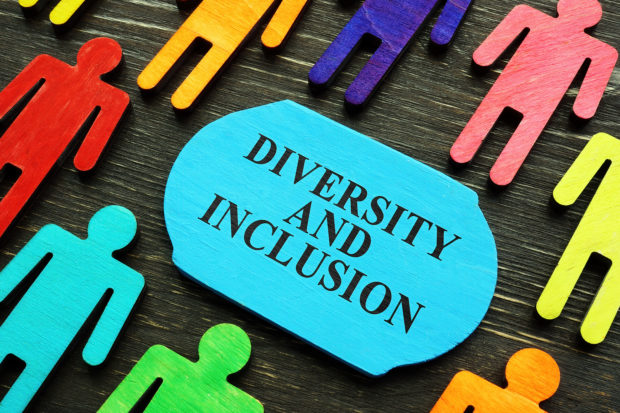Companies need to stop paying lip service to creating a diverse and inclusive workplace and actually take action to make it happen. That means investing time and resources into setting clear goals and expectations, figuring out a way to measure progress, rethinking processes, and holding individuals throughout the organization accountable for doing their part in driving D&I, said Angela Peacock, CEO of PDT Global, during a panel at last month’s IICF Inclusion in Insurance Forum.
Peacock said she thinks “the whole diversity and inclusion industry at the moment is guilty of premature self-congratulation…Very often, we’re seeing organizations win diversity awards…and the very next day declaring gender pay gaps or ethnicity pay gaps that quite frankly deserve them to be publicly whipped in the street, not held up in high regard.”
Most companies still have a long way to go when it comes to narrowing those gaps, she said. It could take generations, she suggested, noting that “it’s not my daughter that would stand the same chance of my son of being your next CEO…[and] it’s not my granddaughter that would stand the same chance as my grandson of being your next CEO. At our current rate of progress, in most countries and in most organizations, it would be my great-granddaughter that would stand the same chance as my great-grandson of being your next CEO—and then only if she were Caucasian and only if she were heterosexual. Any other move away from those characteristics would knock it back potentially another generation.”
Peacock discussed nine “levers” that need to be implemented if an organization truly wants to be inclusive, but she cautioned that “unless we implement them all together and at the same time, then actually we scupper any effects that any of the work we’re doing might have.”
- Watch your language.
Peacock said that you need to begin by agreeing on a clear definition of diversity and inclusion—what they mean and what they do—and then look at how each can affect your business.
She defined diversity as “anything that if it were possible to ask (and in some jurisdictions it’s not) and people were willing to share (and they are not always willing to share), you could measure it.”
However, she noted that having a diverse workforce isn’t enough. “You can bring the most diverse group of people to the table you like—red, yellow, Black, white, gay, straight. Hell, you can even have women there. But if what’s going on around the outside of them is toxic, you will eat away at them day by day, step by step, moment by moment, until finally the prophecy of the fact ‘they are not as good as us’ gets proven…We make it so because of the environments we bring the diversity into and the lack of honest appraisal for what we need to do differently.”
She said that’s where inclusion comes in, defining it as “creating an environment where everyone with the capability to excel can do so.”
- Make a case for D&I.
Clearly articulate the business case for D&I in your organization. Be specific—don’t just make a grand diversity statement that talks about “enhancing creativity and innovation” or “increasing engagement.” People aren’t listening anymore, and they’re not buying into it.
- Measure wisely.
Find a way to measure inclusion and actually hold people accountable. If you’re not measuring it, you can’t prove it, Peacock said.
Employment engagement surveys are a useful measuring tool. Make sure there are several questions where people can indicate whether they feel included in your organization. Do they feel valued? Heard? Do they feel like they will be promoted?
Look at hiring numbers as well as talent velocity, she said. How fast is the diverse talent you hired actually moving through the organization? And hold individual managers accountable for the way they have driven inclusion forward in the past six months, one year, etc.
- Make the procurement director your friend.
Peacock noted that procurement directors have “held their organizations to account for things like modern slavery and also things like sustainability…[and] have pushed out to insist vendors fall into line from a compliance point of view around those topics.” She believes they can do the same for diversity and inclusion. Companies need to look down through their supply chain and insist they all meet a certain standard in terms of their own D&I.
- Make training and embedding mandatory.
Compulsory training can only go so far; without embedding, it’s a one-off experience. Peacock said managers need to also have follow-up discussions with their teams about how they’re going to use that training to drive D&I forward.
- Leverage the performance management system.
Encourage individuals to drive inclusion in the organization and measure their progress. This may help encourage people to attend different employee resource group (ERG) meetings or to mentor someone from a different race or gender.
- Ensure D&I and HR are empowered.
Councils, committees and ERG groups can be valuable in driving inclusion, but they need to be held accountable, not just be an excuse to have yet another inspirational speaker. Ask them to draw up a comprehensive business plan, including specific ways they can make an impact on the organization.
- Try to rid your processes of bias.
Peacock said it’s important to admit that “every single process you have, from recruitment to who you choose to go on projects with,…will be heavy with bias.”
To start getting rid of that bias, one simple step is looking at the “unwritten rules” and “working out the levels of toxicity” in them, she said. Then it’s time to identify the “pinch points of bias” in your processes. For example, she noted that many job descriptions have so many requirements that they actually discourage diversity. Instead, she advised using the “smallest amount of criteria possible to attract the broadest diversity group possible.”
It’s also important to look at how interviews are being conducted. The criteria for the interview should correlate with the job role and be scored independently. And that scoring should be ready to be shared and justified before a hiring decision is made.
- Make sure the C-suite means it.
If your D&I lead has been given no resources in terms of people or finances, good intentions will not make a difference, Peacock said, noting that you “can’t create diversity on a shoestring.”





















 Insurance Costs, Climate Concerns Factor Heavily in U.S. Home Buying Decisions
Insurance Costs, Climate Concerns Factor Heavily in U.S. Home Buying Decisions  Underwriter, Actuary Fears of AI Drop; Work Needed on Collaboration
Underwriter, Actuary Fears of AI Drop; Work Needed on Collaboration  Is the AI Boom a Bubble Waiting to Pop? Here’s What History Says
Is the AI Boom a Bubble Waiting to Pop? Here’s What History Says  NOAA Announces Latest AI-Driven Global Weather Models
NOAA Announces Latest AI-Driven Global Weather Models 










